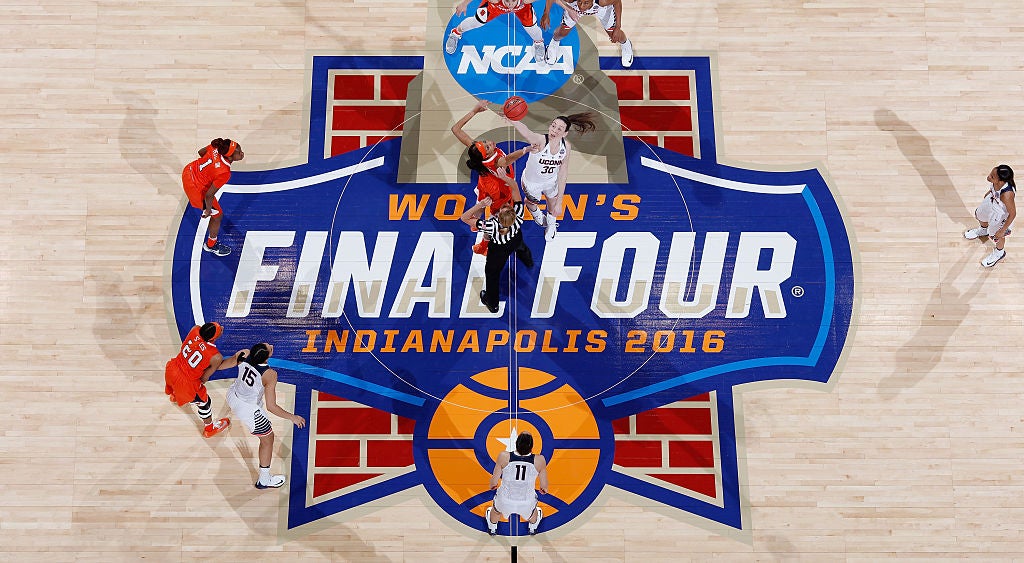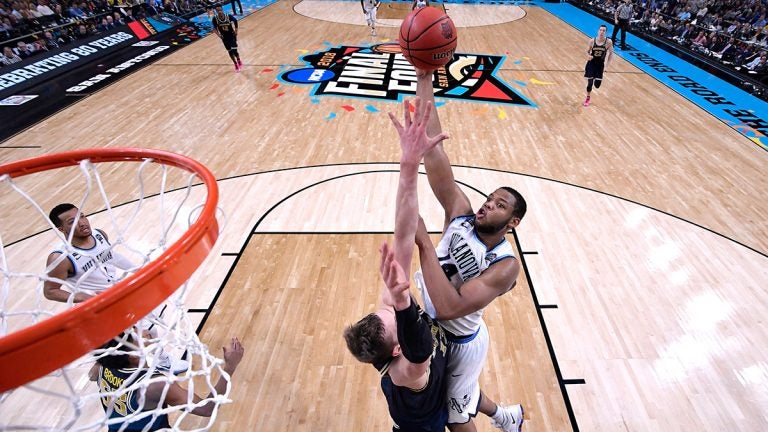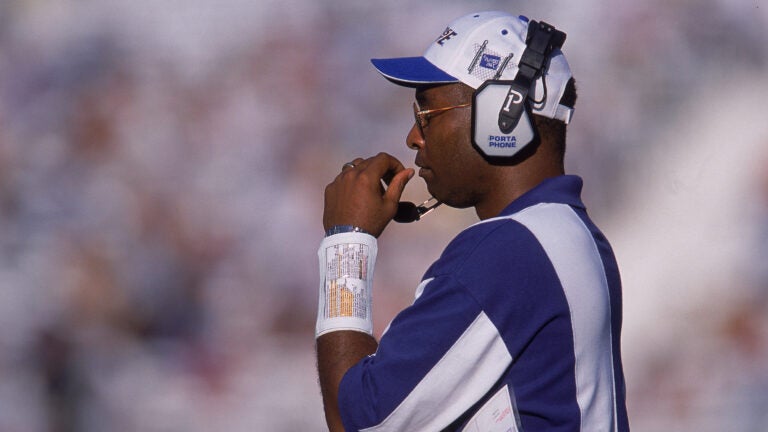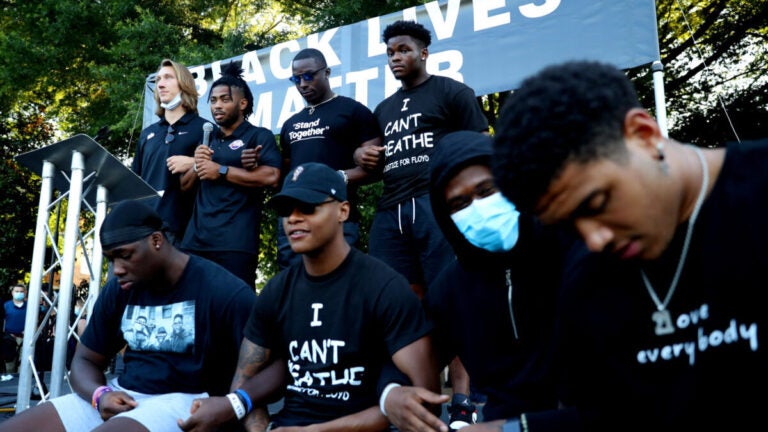Women’s Worth: How Female NCAA Athletes Will Profit in the New Era of NIL Rights
Why this matters
As discussions about the NCAA’s treatment of women’s basketball players vis-a-vis their male counterparts reach a high, Patrick Hruby says that the argument allowing college athletes to profit from their NILs will somehow 'hurt' women is actually the opposite.
As a prospective college athlete, Hayley Hodson got used to saying no.
No to the sunglasses brand that asked Hodson, then a 17-year-old high school volleyball star who trained with the U.S. Women’s National Team, to model a pair on Instagram.
No to Roxy, the clothing company that made her club team’s jerseys and wanted Hodson and her teammates to tag photos of themselves wearing its gear on social media.
No to the television producer who contacted Hodson and her parents out of the blue, wanting to put together a reality show based on—no joke—tall families.
“That was a little weird,” Hodson says with a laugh. “But it still would have been nice to cultivate a relationship with that producer, instead of being like, ‘I really can’t talk to you.’”
Hodson couldn’t talk—or capitalize on those other opportunities—because she didn’t want to run afoul of National Collegiate Athletic Association amateurism rules barring athletes and recruits from accepting compensation connected to playing sports, including profiting from the use of their names, images, and likenesses (NILs).
Those rules, Hodson says, even prevented her from keeping the water bottles and beach towels that she won while competing in beach volleyball tournaments near her Newport Beach, Calif. home.
“I was literally told [by colleges] that ‘you can’t accept that,’” says Hodson, 24, who played volleyball for Stanford University before medically retiring following a brain injury and now attends law school at the University of California, Los Angeles. “You’re paying the price of admission to play in these tournaments—you should at least be able to take the towel. Are you kidding?
“Now think about that on a macro level. Think about all the opportunities that are taken from you as an athlete before they even emerge. All I saw was potential that I couldn’t tap into.”
For college athletes, that’s about to change. As soon as this summer, new state laws will begin allowing them to cash in on their NILs, upending the NCAA’s longtime prohibition on pay and ushering in a new era of endorsement deals, influencer campaigns, and other commercial opportunities.
While some of the most lucrative opportunities undoubtedly will flow to star athletes in the prominent television sports of football and men’s basketball, women college athletes also are poised to capitalize—and may even enjoy a bigger financial boost than their male counterparts relative to the popularity of their sports:
- According to the online athlete marketing platform Opendorse, Fresno State University basketball players Hanna and Haley Cavinder, twin sisters who have 2.7 million followers on TikTok, could earn more than $167,000 annually from social media posts.
- A study conducted last year by the website AthleticDirectorU and the marketing firm Navigate Research found that of the 25 college athletes with the greatest endorsement potential, 13 were women, with annual endorsement potential between $466,000 and $63,000.
- Aquinas College volleyball player Chloe Mitchell, who is believed to be the first athlete to earn money under the National Association of Intercollegiate Athletics’ recently liberalized NIL rules, has endorsement deals with two mini-golf brands thanks to her status as a do-it-yourself project social media influencer.
“So far, almost all of the media attention on NIL rights is on the Zion Williamson type of athlete,” says Opendorse marketing director Sam Weber, referring to the former Duke University basketball star. “What’s the Heisman [Trophy] contender, the Naismith [Award] finalist going to earn?"
“Those big name [male] athletes are going to have a very real opportunity on their hands to make a very real amount of money—tens or hundreds of thousands of dollars a year is realistic. But the Cavinder twins are among the most influential college athletes in the country. They’ll have every chance to make as much as the Zion Williamsons make. And there will be plenty of other opportunities for women athletes.”
“The ultimate equalizer”
When California governor Gavin Newsom in September 2019 signed into a law a bill that prevents the state’s colleges from punishing their athletes for profiting from their NILs starting in 2023, it sent ongoing shockwaves through NCAA sports—prompting the association to weigh rules changes, other states to consider and pass similar legislation, and members of Congress to propose bills of their own.
Meanwhile, athletes like Stanford soccer player Bianca Caetano-Ferrara have been left to wonder how the coming shift will affect them.
“Initially, the conversations among me and my teammates were, ‘oh my gosh, this is exciting, maybe we could get a[n endorsement] contract with [women’s apparel brand] Lululemon,” says Caetano-Ferrara, also a member of the women’s sports advocacy organization Voice In Sport. “But as people have had more time to think about it, there’s been a lot of concern about how this might affect men and women differently. Is this going to end up with football and men’s basketball getting all of the money?”
Opendorse CEO Blake Lawrence repeatedly has been asked the same question. A former Nebraska linebacker, he founded the company in 2012 to help his friend and former teammate Prince Amukamara navigate online endorsements as a professional athlete; more recently, Opendorse has been working with schools including his alma mater and Clemson University to help college athletes and athletic departments alike prepare to do the same.
Lawrence believes that traditional NIL opportunities—think national television ads or sneaker endorsements—will be “top heavy,” favoring football and men’s basketball players at the Power Five conference schools that already collect the bulk of the broadcast money in college sports. But social media is a different story.
When Lawrence played at Nebraska in the late aughts, Facebook and Twitter were in their infancy; TikTok and Instagram did not yet exist. During a recent Aspen Institute panel discussion on college sports NIL changes, Lawrence recalled attending a school meeting where athletes were told not to use social platforms because doing so might harm their reputations. “It was all scare tactics,” he said.
Times change. Worth an estimated $8 billion in 2019, the social media influencer industry is predicted to grow to $15 billion by next year. Lawrence expects that college athletes will realize most of their NIL opportunities within that market, where how well you play on the field—or how often your team plays on ESPN—can be less important than how engaging you are to your followers.
A recent study found that while women college athletes receive less than four percent of all coverage in traditional media channels, the median male and female college athletes have comparable numbers of social media followers.
“The ultimate equalizer is the rise of influencer marketing,” said Lawrence during the Aspen discussion. “Using your online persona to build your own brand. It depends on how large of an audience you can build.”
Large audiences can mean big dollars. Before the current basketball season, University of Connecticut basketball star Paige Bueckers had more than 475,000 followers on Instagram and 25,000 on Twitter. Based on what professional athletes are paid for social media endorsement deals, Opendorse estimated that Bueckers’ value could be around $670,000 a year—higher than that of Clemson quarterback Trevor Lawrence, one of college football’s most popular players.
Similarly, the 2020 study of college athletes with the most online endorsement potential by AthleticDirectorU placed female basketball, volleyball, softball, track and field, tennis, and gymnastics participants in the top 25. UCLA’s women’s gymnastics team alone was estimated to have as much as $1.25 million of annual endorsement value.
When Opendorse analyzed Nebraska, Weber says, it found that the athlete with the second-highest earning potential at the school was volleyball player Lexi Sun, the school’s most-followed athlete on Instagram.
That finding wasn’t a fluke. While Nebraska’s football team has a large and passionate fanbase, its volleyball program is one of the best in the nation and the school’s second-most followed team online. According to Opendorse, its players stand to earn an average of $5,747 annually through social media endorsements—more than the average for their football counterparts.
“If you look at a more regional or local level for [NIL] value, Nebraska is a good example of what it could be worth for women athletes,” Weber says.
“The volleyball players on campus stack up right alongside the most influential football players.”
Stephanie Stabulis, who has worked in online marketing for a decade, says that companies are eager to hire college athletes as social media influencers—particularly health, fitness, wellness, and sports performance brands trying to connect with customers between the ages of 18 and 25.
“You need ambassadors and spokespeople who are the same age, because those people are not paying attention to 35-year-olds, they are at a different place in their lives,” Stabulis says. “And you want people who are training at the highest level of sports, every day. As a strategist working in an [ad] agency, I would butt my head against the wall because we couldn’t tap into NCAA athletes.”
Stabulis expects sports-related online NIL opportunities to be as plentiful for women college athletes as for men. She also suspects that women may have an easier time branching out into non-sports endorsements. “Influence is based on interpersonal relationship building, the ability to emotionally connect with people,” she says. “Who you are off the field can hold as much weight as who you are on the field or what you do there.”
Case in point? In 2017, then-University of Southern California volleyball player Victoria Garrick gave a Ted Talk about mental health and her struggles with performance anxiety, depression, and an eating disorder. She subsequently started a YouTube channel to discuss mental health in college sports, grew a large audience of followers, and has now built a self-sustaining brand and business out of her advocacy.
Because of NCAA rules, Garrick wasn’t able to earn money for her work until after she graduated. By contrast, the New York Times recently reported that college cheerleaders—athletes who are not governed by the association—can and do monetize their social media accounts, partnering with major brands including Amazon, Colgate, and Nissan and sometimes earning more than $5,000 per promotional post.
Rep. Lori Trahan (D-Mass.), a former Georgetown University volleyball player, is currently sponsoring a bill in the House of Representatives that essentially would create a free market for college athlete NILs. Citing college cheerleaders as an example, she said that her interest in the topic stems largely from her belief that NIL deals will benefit women’s sports.
“Many of these young women are astonishing athletes,” Trahan said. “It’s a sport in its own right. But it is not governed by the NCAA. What that [Times article] signaled to me is, in fact, there is a market for athletes beyond the stars we watch during March Madness or [football] bowl season.”
“There’s lots of ways we could have benefitted”
The first person in her family to attend college, Trahan was only able to afford attending Georgetown because of her volleyball scholarship—and even then, she said, she converted her school meal plan into cash one semester so that she would “have money to live.”
Meanwhile, Trahan wasn’t able to work as an instructor at summer volleyball skills camps. “It would have violated my amateur status,” she said. “But I had to make money. So I spent my summers waiting tables at TGI Friday’s, rather than make a few hundred dollars serving as a positive role model for young women.”
Opendorse estimates that the total national market for college athlete NILs in 2022 could be as high as $274 million. And that total isn’t limited to social media endorsements. An ESPN analysis found that star college athletes could earn between $10,000 and $20,000 for sponsoring and making appearances at a summer sports camp, while less-celebrated players could make between $1,000 and $2,000 a week by working as instructors.
Similarly, athletes could make as much as $200 an hour giving individual and small-group lessons.
“I’m from central Nebraska and grew up a diehard Huskers fan,” says Opendorse’s Weber. “Every year, between six and a dozen kids from the non-metro areas in the state walk onto the [school’s] football team. Nobody else in the country cares about them, but those walk-on linemen mean a hell of a lot to those small towns. If they could come back in the summers to host skill camps, you can bet every eighth-grader in their counties would come and pay fifty bucks to attend.”
The same ESPN story lists other ways college athletes could profit from their NILs: regional and local commercials and personal appearances; autograph and memorabilia signing sessions; modeling and brand ambassador deals with sports gear and athleisure wear companies; and even shoutouts on Cameo, an app that lets fans pay to have celebrities record a short, personalized message.
Not all NIL opportunities will be for cash. Brittany Collens, a former University of Massachusetts, Amherst tennis player who now competes professionally, says that many of her current sponsorship deals are for goods and services, like sports supplements that she uses in exchange for posting about them on her Instagram account and practice court time at tennis clubs that she receives for teaching lessons.
“When I think back to college, there’s lots of ways we could have benefited from our NILs,” says Collens, who has lobbied Massachusetts lawmakers to pass legislation similar to California’s. “A number of my teammates had several medical expenses that they had to pay out of pocket. I had to get cortisone shots for my knee. What if we could have endorsed those doctors or clinics?”
During a recent Zoom call with Iowa lawmakers considering NIL legislation, college athlete advocate Ramogi Huma watched as a University of Iowa women’s basketball player explained that for many female athletes, professional opportunities are limited or nonexistent—which in turn means that their college careers are also their peak potential earning years in sports.
Louisiana State University gymnast Olivia Dunne, for example, has nearly five million social media followers that could be worth hundreds of thousands of dollars a year. As ESPN writer David Hale points out, each day the NCAA and lawmakers delay in moving NIL reform forward costs her money.

“Social media opportunities are definitely time-sensitive,” Dunne told Hale. “There's no professional sports for gymnastics, so I want to be making money while I can, right? I feel like [male athletes] have a different opportunity than I do, so it's a bit unfair.”
“For women, there are less opportunities to fully capitalize on their talents in sport,” says Huma, the executive director of the National College Players Association, a nonprofit advocacy group that has been instrumental in the creation and adoption of NIL legislation. “And alongside that, the current NIL prohibitions restrict players from things that are outside of sports.”
To illustrate, Huma points to Dylan and Dakota Gonzalez, twin sisters and social media stars who quit the basketball team at the University of Nevada, Las Vegas because NCAA NIL rules prevented them from pursuing outside business opportunities. At one point, the two reportedly were reprimanded by the association for playing in a charity game; to avoid a multi-game suspension, they were required to give a presentation to other athletes about what they could and couldn’t do with their NILs.
“There are plenty of creative and talented college athletes that can engage in small business activities that have very little to do with their sports,” Human says. “Right now, they’re not allowed to pursue that.”
Collens, who likens managing her pro tennis career to running a small business, says that her NIL opportunities have been self-reinforcing: the more that she’s able to do, the more that come her way. “That’s helping me advance my tennis career, too,” she says. “Even stuff that isn’t lucrative can connect you with more people that will lead to opportunities in the future.”
Caetano-Ferarra, the Stanford soccer player, believes that relaxing NIL rules could have a similar effect on women’s college sports as a whole. “One of the biggest issues in women’s sports is the visibility around it, the hype,” she says. “Sponsorship deals can bring more of that energy. You get more people watching, more attention on social media, more young girls looking up to female athletes and influencers, and then schools want to put more money toward those teams. It could snowball.”
Exactly when and how that will happen remains to be seen. Despite announcing last November its intention to create new NIL rules, the NCAA has yet to follow through. Meanwhile, Congress is considering six different national bills; six states including New Jersey, Nebraska, and Michigan already have passed laws; and 31 states reportedly are considering legislation, some of which could go into effect July 1 or earlier.
NCAA and school officials and some lawmakers have expressed fears that NIL liberalization will harm college sports by giving schools in larger cities and media markets a recruiting advantage, siphoning money away from women’s sports and toward football and men’s basketball, and even making it harder for athletes to study. But the experience of Mitchell, the NAIA volleyball player and DIY social media influencer already endorsing brands, suggests that those concerns may be overblown.
Working with her father, Keith—a former University of Michigan football player who once won a red Trans-Am on “The Price is Right” and subsequently registered the prize in his brother’s name to stay on the right side of NCAA rules—she has created an online platform called PlayBooked that connects sponsors and college athletes. According to ESPN, the platform already has facilitated a deal between an apparel company and 10 Aquinas College athletes and is helping other NAIA athletes get paid between $30 and $100 for social media posts.
Arizona State University softball player Olivia Miller isn’t surprised by those numbers. Recently, she says, one of her teammates posted a TikTok video that went viral. “She had maybe 500 followers before posting, and the next morning she came into the locker room and had gone to 28,000 followers,” Miller says. “There was a ‘M’ next to the number of views. Millions.”
Miller’s teammate lamented that she couldn’t join TikTok’s $200 million “creator fund,” which pays users for their content, because of NCAA rules. “She was like, ‘I want to enroll and make money,’” Miller says with a laugh. “And I was like, ‘good luck—but don’t get caught.’”
In the future, Miller says, that won’t be a concern. Instead of having to say no, college athletes like her teammate will be able to say yes. “I play softball,” she says. “I’m not a starting player. But what I learned from that is us normal athletes will have opportunities from our NILs, too. And that’s a good thing. It’s exciting. It’s about time that it’s going to happen.”
Monthly Issue
The Power of Women & Girls in Sport
From participation to coaching, and shattering leadership ceilings, 2020 was slated to be a year of progress for women’s sport. But then came the pandemic.
2021 could still stand to be a significant year of growth for women and girls in sport. What long-standing barriers and future opportunities lie ahead?





